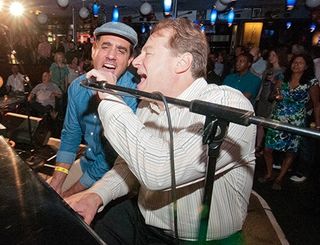The Five Spot: Loren Toolajian

Loren Toolajian specializes in sound. Sandblast, the post house he runs with partners Ralph Kelsey and Mike Ungar, helps an array of shows from Vice to Homeland to Ghost Adventures mix, design and score. Tools is a true multi-hyphenate—composer, music director, radio producer, program director, entrepreneur. Over 30 years in New York, he has racked up at least 8 million stories—the Sam Shepard play he worked on with T. Bone Burnett, bonding with opera tenors, the Muppets, Arthur Miller and more. Sandblast is at Broadway and 50th Street, the Brill Building-adjacent address where Carole King, Neil Sedaka and Bert Berns wrote classics including “Loco-Motion,” “Piece of My Heart” and “Twist and Shout.” The building’s basement club, Iridium, hosted guitar pioneer Les Paul every Monday night for decades and remains a vibrant concert venue. “LT,” as he is known, is now part of a new venture streaming Iridium concerts direct to consumers. An edited version of Toolajian’s talk with B&C editor Dade Hayes follows.
Why is sound so crucial to how we watch TV?
There are all sorts of pieces to that puzzle. How do you bring up the bass without overwhelming the high end? How do you emphasize the voice without making the music disappear? How do you blend it all together so that all the frequencies are dancing together and weaving together instead of fighting each other?
Describe Sanblast’s portfolio.
We work on all sorts of things. We just did a national spot for LG. We do feature films, TV series—events like the ESPYs, which we have handled for 16 years.
How is a live event like the ESPYs different from something prerecorded, sound-wise?
There are people trying to mix for the people in the room, and people mixing for TV, and that can be a nightmare to coordinate. It’s like on Saturday Night Live—when you go to SNL, that band is smokin’, man. It’s as good a band as there is. But when you watch it on TV, it’s like, ‘Ehhh…’ That’s part and parcel of what we do. How do we use the tools that we have? Compression. Delay. Reverb. And our skills as mixers, developed over time, to create an audio picture.
Broadcasting & Cable Newsletter
The smarter way to stay on top of broadcasting and cable industry. Sign up below
Original programming has exploded—is that boosting demand for music supervisors, composers and other sound pros?
People are reaching out to people like T. Bone Burnett because everybody is looking for a signature. We are attracted to and depend on these frequencies that dance around us. We’re vibrating. Music’s vibrating. That sounds very mumbo-jumbo, let’s-eat-granola-and-hang-out. But when you hear something that captures your attention, that moves you, you can’t get enough of it. Everybody is trying to find that. You hear Leonard Cohen doing his thing [in True Detective’s second-season title sequence] and you say, ‘What is this?!’
Do the best TV auteurs have a musical gene, a feel for music?
For anyone worth their salt, music and character are inextricably intertwined. Music and sound are essential to driving things forward, even if you’re not paying attention to it. With a lot of film and TV music, let’s face it, you’re not really focused on it. You’re focused on an actor or what they’re saying. You’re trying to get the story. But then you start to understand how sound helps convey all of that. There’s nothing like it.
